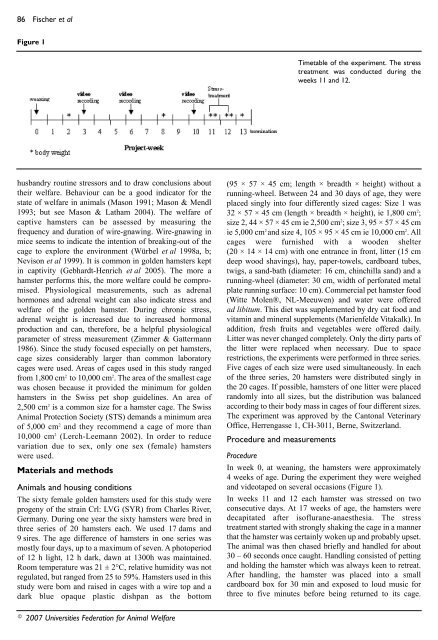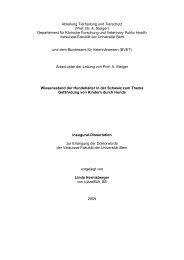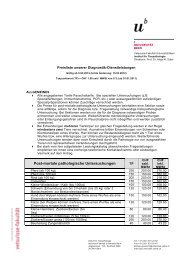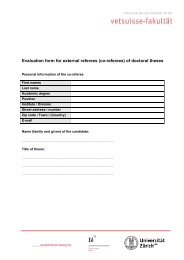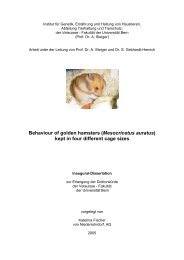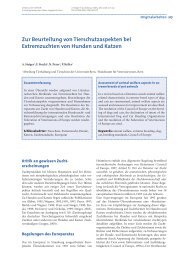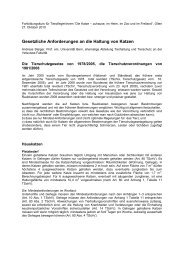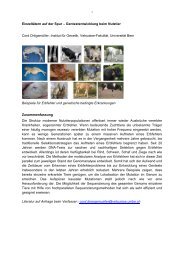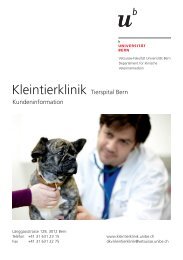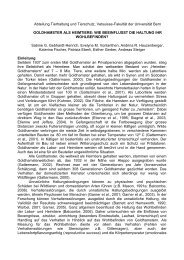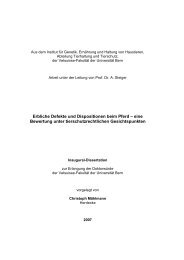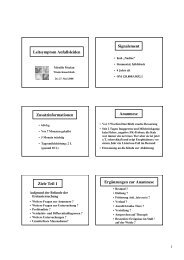Behaviour of golden hamsters (Mesocricetus auratus) kept in four ...
Behaviour of golden hamsters (Mesocricetus auratus) kept in four ...
Behaviour of golden hamsters (Mesocricetus auratus) kept in four ...
You also want an ePaper? Increase the reach of your titles
YUMPU automatically turns print PDFs into web optimized ePapers that Google loves.
86 Fischer et alFigure 1Timetable <strong>of</strong> the experiment. The stresstreatment was conducted dur<strong>in</strong>g theweeks 11 and 12.husbandry rout<strong>in</strong>e stressors and to draw conclusions abouttheir welfare. <strong>Behaviour</strong> can be a good <strong>in</strong>dicator for thestate <strong>of</strong> welfare <strong>in</strong> animals (Mason 1991; Mason & Mendl1993; but see Mason & Latham 2004). The welfare <strong>of</strong>captive <strong>hamsters</strong> can be assessed by measur<strong>in</strong>g thefrequency and duration <strong>of</strong> wire-gnaw<strong>in</strong>g. Wire-gnaw<strong>in</strong>g <strong>in</strong>mice seems to <strong>in</strong>dicate the <strong>in</strong>tention <strong>of</strong> break<strong>in</strong>g-out <strong>of</strong> thecage to explore the environment (Würbel et al 1998a, b;Nevison et al 1999). It is common <strong>in</strong> <strong>golden</strong> <strong>hamsters</strong> <strong>kept</strong><strong>in</strong> captivity (Gebhardt-Henrich et al 2005). The more ahamster performs this, the more welfare could be compromised.Physiological measurements, such as adrenalhormones and adrenal weight can also <strong>in</strong>dicate stress andwelfare <strong>of</strong> the <strong>golden</strong> hamster. Dur<strong>in</strong>g chronic stress,adrenal weight is <strong>in</strong>creased due to <strong>in</strong>creased hormonalproduction and can, therefore, be a helpful physiologicalparameter <strong>of</strong> stress measurement (Zimmer & Gattermann1986). S<strong>in</strong>ce the study focused especially on pet <strong>hamsters</strong>,cage sizes considerably larger than common laboratorycages were used. Areas <strong>of</strong> cages used <strong>in</strong> this study rangedfrom 1,800 cm 2 to 10,000 cm 2 . The area <strong>of</strong> the smallest cagewas chosen because it provided the m<strong>in</strong>imum for <strong>golden</strong><strong>hamsters</strong> <strong>in</strong> the Swiss pet shop guidel<strong>in</strong>es. An area <strong>of</strong>2,500 cm 2 is a common size for a hamster cage. The SwissAnimal Protection Society (STS) demands a m<strong>in</strong>imum area<strong>of</strong> 5,000 cm 2 and they recommend a cage <strong>of</strong> more than10,000 cm 2 (Lerch-Leemann 2002). In order to reducevariation due to sex, only one sex (female) <strong>hamsters</strong>were used.Materials and methodsAnimals and hous<strong>in</strong>g conditionsThe sixty female <strong>golden</strong> <strong>hamsters</strong> used for this study wereprogeny <strong>of</strong> the stra<strong>in</strong> Crl: LVG (SYR) from Charles River,Germany. Dur<strong>in</strong>g one year the sixty <strong>hamsters</strong> were bred <strong>in</strong>three series <strong>of</strong> 20 <strong>hamsters</strong> each. We used 17 dams and9 sires. The age difference <strong>of</strong> <strong>hamsters</strong> <strong>in</strong> one series wasmostly <strong>four</strong> days, up to a maximum <strong>of</strong> seven. A photoperiod<strong>of</strong> 12 h light, 12 h dark, dawn at 1300h was ma<strong>in</strong>ta<strong>in</strong>ed.Room temperature was 21 ± 2°C, relative humidity was notregulated, but ranged from 25 to 59%. Hamsters used <strong>in</strong> thisstudy were born and raised <strong>in</strong> cages with a wire top and adark blue opaque plastic dishpan as the bottom(95 × 57 × 45 cm; length × breadth × height) without arunn<strong>in</strong>g-wheel. Between 24 and 30 days <strong>of</strong> age, they wereplaced s<strong>in</strong>gly <strong>in</strong>to <strong>four</strong> differently sized cages: Size 1 was32 × 57 × 45 cm (length × breadth × height), ie 1,800 cm 2 ;size 2, 44 × 57 × 45 cm ie 2,500 cm 2 ; size 3, 95 × 57 × 45 cmie 5,000 cm 2 and size 4, 105 × 95 × 45 cm ie 10,000 cm 2 . Allcages were furnished with a wooden shelter(20 × 14 × 14 cm) with one entrance <strong>in</strong> front, litter (15 cmdeep wood shav<strong>in</strong>gs), hay, paper-towels, cardboard tubes,twigs, a sand-bath (diameter: 16 cm, ch<strong>in</strong>chilla sand) and arunn<strong>in</strong>g-wheel (diameter: 30 cm, width <strong>of</strong> perforated metalplate runn<strong>in</strong>g surface: 10 cm). Commercial pet hamster food(Witte Molen®, NL-Meeuwen) and water were <strong>of</strong>feredad libitum. This diet was supplemented by dry cat food andvitam<strong>in</strong> and m<strong>in</strong>eral supplements (Marienfelde Vitakalk). Inaddition, fresh fruits and vegetables were <strong>of</strong>fered daily.Litter was never changed completely. Only the dirty parts <strong>of</strong>the litter were replaced when necessary. Due to spacerestrictions, the experiments were performed <strong>in</strong> three series.Five cages <strong>of</strong> each size were used simultaneously. In each<strong>of</strong> the three series, 20 <strong>hamsters</strong> were distributed s<strong>in</strong>gly <strong>in</strong>the 20 cages. If possible, <strong>hamsters</strong> <strong>of</strong> one litter were placedrandomly <strong>in</strong>to all sizes, but the distribution was balancedaccord<strong>in</strong>g to their body mass <strong>in</strong> cages <strong>of</strong> <strong>four</strong> different sizes.The experiment was approved by the Cantonal Veter<strong>in</strong>aryOffice, Herrengasse 1, CH-3011, Berne, Switzerland.Procedure and measurementsProcedureIn week 0, at wean<strong>in</strong>g, the <strong>hamsters</strong> were approximately4 weeks <strong>of</strong> age. Dur<strong>in</strong>g the experiment they were weighedand videotaped on several occasions (Figure 1).In weeks 11 and 12 each hamster was stressed on twoconsecutive days. At 17 weeks <strong>of</strong> age, the <strong>hamsters</strong> weredecapitated after is<strong>of</strong>lurane-anaesthesia. The stresstreatment started with strongly shak<strong>in</strong>g the cage <strong>in</strong> a mannerthat the hamster was certa<strong>in</strong>ly woken up and probably upset.The animal was then chased briefly and handled for about30 – 60 seconds once caught. Handl<strong>in</strong>g consisted <strong>of</strong> pett<strong>in</strong>gand hold<strong>in</strong>g the hamster which was always keen to retreat.After handl<strong>in</strong>g, the hamster was placed <strong>in</strong>to a smallcardboard box for 30 m<strong>in</strong> and exposed to loud music forthree to five m<strong>in</strong>utes before be<strong>in</strong>g returned to its cage.© 2007 Universities Federation for Animal Welfare


